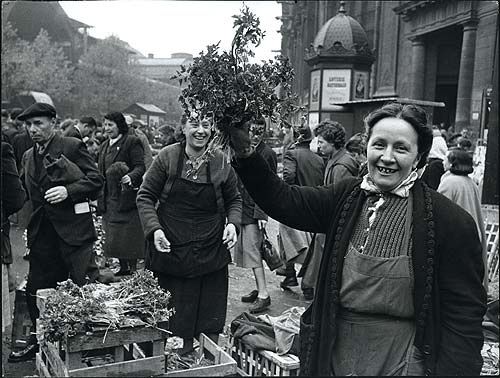
A pre-dawn parade of horse-drawn carts laden with produce en route to Les Halles, Paris’ great public food market (pictured above by Robert Doisneau), opens Emile Zola’s 1873 novel, Le Ventre de Paris. Although his story is a contemporary one, the scene would have been familiar to a Parisian of the 18th or even 12th century. The daily train of foodstuffs wending its way into the city from the farms outside its walls is as old as the very first city – as old even as the very idea of the city.
And what is that idea? That a critical mass or persons might concentrate themselves in a single, high-density community with a view to pursuing occupations not directly linked to agriculture. Kings, courtiers, administrators, warriors, stargazers, priests, artisans, and merchants can emerge only when the tedious task of food production has been outsourced to a peasantry who, in return for the use of land to support themselves, agree to share the bounty of their fields and vineyards with the city.
The story of centrally-organized, cereal agriculture in the ancient Near East is well-known; less so its lengthy romance with wine imported from the remote vineyards of present-day Georgia, Armenia, and Turkey. Moving wine from its source in the mountains into the population centers of Mesopotamia was arduous and something no one undertook without the prospect of profit.
As Nineveh and Babylon drained the vineyards of the mountains far to their north, grape wine emerged as an important marker of wealth and elite status. In exactly the same way, Paris would become a sponge for the wines of Champagne and Burgundy long before Zola’s era. By the 13th century, Bordeaux was growing rich slaking the thirst of London’s wealthy nobles and bourgeois with its marvelous claret; with the thirsty metropolitan markets of the Low Countries and northern Germany not far behind.
You can make the same argument for the magnetic power exerted by Vienna, Madrid, and Naples and many other cities on the wine regions within their spheres of influence. It was there that wines competed for the attention and cash of consumers and there that a critical consuming public for wine gradually took shape. Cities don’t produce wine, but they attract it, absorb it, consume it – and eventually make it over in their own image.
Urban markets demanded wines that could bear the stresses of travel. They also required wines with stabilizing levels of alcohol that wouldn’t go off in days or weeks of being put into the cellar. Lastly, of course, they wanted wine that tasted delicious. Champagne, Port, Sherry, and Madeira are examples of wines that exist as categories today solely as a result of consumer demand issuing from population centers far from the vineyards where grapes grew.
No wine intended for market rather than for immediate local consumption has a credible claim to be solely the creation of its winemaker, no matter how visionary. This is because the fundamental structures of wine – including agreed-upon levels of wholesomeness, drinkability and durability — are social constructions, erected over time as producers made adjustments based on the preferences and needs of the sophisticated consumers in urban hubs.
Creativity in winecraft has always existed, but only within certain relatively narrow, normative bounds which are widely acknowledged and closely monitored.
Everything we know about the development of the world wine trade argues against the idea that gains in the stability, authenticity, and quality that characterize modern wine could have been achieved apart from the influence of cities that not only demanded better and more durable wines, but were willing to pay the bill for the centuries of R&D that made them possible.
In this sense, wine is always much more than an agricultural product made by them. It’s a cultural artifact made by us.